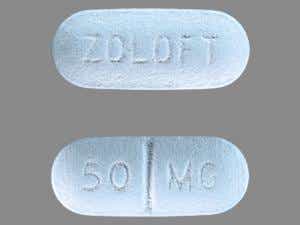Talk:Sertraline
This page has not been fully approved by the PsychonautWiki administrators. It may contain incorrect information, particularly with respect to dosage, duration, subjective effects, toxicity and other risks. It may also not meet PW style and grammar standards. |

Serotonin syndrome and/or a prolonged heart QT interval can occur with using SSRIs (such as citalopram, paroxetine, or sertraline) with SNRIs, SRAs (such as MDMA), DXM, serotonergic stimulants (such as cocaine), MAOIs, and RIMAs.
It is strongly discouraged to consume moderate to heavy dosages of these substances together.
| Sertraline | |||||||||||||||||||||||||||
|---|---|---|---|---|---|---|---|---|---|---|---|---|---|---|---|---|---|---|---|---|---|---|---|---|---|---|---|
| Chemical Nomenclature | |||||||||||||||||||||||||||
| Common names | Zoloft, Lustral | ||||||||||||||||||||||||||
| Substitutive name | Sertraline | ||||||||||||||||||||||||||
| Systematic name | (1S,4S)-4-(3,4-dichlorophenyl)-N-methyl-1,2,3,4-tetrahydronaphthalen-1-amine | ||||||||||||||||||||||||||
| Class Membership | |||||||||||||||||||||||||||
| Psychoactive class | Antidepressant (SSRIs) | ||||||||||||||||||||||||||
| Chemical class | Diphenylamine | ||||||||||||||||||||||||||
| Routes of Administration | |||||||||||||||||||||||||||
|
|||||||||||||||||||||||||||
Sertraline (also known as Zoloft) is an SSRI substance and pharmaceutical of the substituted tametraline chemical class that produces anxiolytic and antidepressant effects when administered. Sertraline is primarily prescribed for major depressive disorder in adult outpatients as well as obsessive-compulsive disorder, panic disorder, and social anxiety disorder, in both adults and children.
Chemistry
Sertraline is a substituted tametraline.
Pharmacology
Sertraline is a selective reuptake inhibitor of serotonin; a class of drug that increases levels of extracellular serotonin, meaning that more serotonin is present in the brain. Sertraline is used for depression and anxiety disorders because it is hypothesized that people with these disorders may have low serotonin levels.
Sertraline promotes neurogenesis (the growth of neurons). This is a useful property in neurodegenerative diseases, such as Huntington's disease.[1][2][3]
Its metabolite, norsertraline, also inhibits reuptake of serotonin, but more weakly than sertraline. [4][5]
Subjective effects
Disclaimer: The effects listed below cite the Subjective Effect Index (SEI), an open research literature based on anecdotal user reports and the personal analyses of PsychonautWiki contributors. As a result, they should be viewed with a healthy degree of skepticism.
It is also worth noting that these effects will not necessarily occur in a predictable or reliable manner, although higher doses are more liable to induce the full spectrum of effects. Likewise, adverse effects become increasingly likely with higher doses and may include addiction, severe injury, or death ☠.
Physical effects 
-
- Orgasm suppression
- Sedation or Stimulation - Sertraline can be somewhat sedating or mildly stimulating. As with other SSRIs, sedation, if present, is usually more pronounced at night.
- Increased heart rate
- Abnormal heartbeat
- Teeth grinding - Teeth grinding and jaw clenching can be present but usually to a much lesser extent than with stimulants.
- Increased perspiration
Cognitive effects 
-
- Anxiety suppression
- Focus suppression
- Mania - Particularly a problem with higher doses or for those who take Sertraline for prolonged periods. Sertraline can trigger a manic episode in people with bipolar disorder.
- Cognitive fatigue
Paradoxical effects 
-
- Suicidal ideation - Sertraline and other SSRIs can cause suicidal ideation, particularly in young people. This is more likely in the early stages of use.[6]
- Anxiety
- Insomnia
Experience reports
There are currently no anecdotal reports which describe the effects of this compound within our experience index. Additional experience reports can be found here:
Legal status
 |
This legality section is a stub. As such, it may contain incomplete or wrong information. You can help by expanding it. |
- Australia: Sertraline is available through a prescription only.[citation needed]
- Brazil: Sertraline is available through a prescription only and is controlled.[citation needed]
- Canada: Sertraline is available through a prescription only.[citation needed]
- Germany: Sertraline is available through a prescription.[citation needed]
- New Zealand: Sertraline is available through a prescription only.[citation needed]
- Russia: Sertraline is available through a prescription.[citation needed]
- United Kingdom: Sertraline is available through a prescription only.[citation needed]
- United States: Sertraline is available through a prescription only.[citation needed]
See also
External links
References
- ↑ Anacker, C., Zunszain, P. A., Cattaneo, A., Carvalho, L. A., Garabedian, M. J., Thuret, S., ... & Pariante, C. M. (2011). Antidepressants increase human hippocampal neurogenesis by activating the glucocorticoid receptor. Molecular psychiatry, 16(7), 738.
- ↑ Peng, Q., Masuda, N., Jiang, M., Li, Q., Zhao, M., Ross, C. A., & Duan, W. (2008). The antidepressant sertraline improves the phenotype, promotes neurogenesis and increases BDNF levels in the R6/2 Huntington's disease mouse model. Experimental neurology, 210(1), 154-163.
- ↑ Duan, W., Peng, Q., Masuda, N., Ford, E., Tryggestad, E., Ladenheim, B., ... & Ross, C. A. (2008). Sertraline slows disease progression and increases neurogenesis in N171-82Q mouse model of Huntington's disease. Neurobiology of disease, 30(3), 312-322.
- ↑ Koe, B. K., Weissman, A. L. B. E. R. T., Welch, W. M., & Browne, R. G. (1983). Sertraline, 1S, 4S-N-methyl-4-(3, 4-dichlorophenyl)-1, 2, 3, 4-tetrahydro-1-naphthylamine, a new uptake inhibitor with selectivity for serotonin. Journal of Pharmacology and Experimental Therapeutics, 226(3), 686-700.
- ↑ Wong, D. T., Bymaster, F. P., & Engleman, E. A. (1995). Prozac (fluoxetine, Lilly 110140), the first selective serotonin uptake inhibitor and an antidepressant drug: twenty years since its first publication. Life sciences, 57(5), 411-441.
- ↑ Didham, R. C., McConnell, D. W., Blair, H. J., & Reith, D. M. (2005). Suicide and self‐harm following prescription of SSRIs and other antidepressants: confounding by indication. British journal of clinical pharmacology, 60(5), 519-525.
